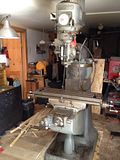Sshire
Well-Known Member
- Joined
- Jun 29, 2011
- Messages
- 936
- Reaction score
- 259
Moya
Thanks for the info. The interesting point is that many replies to this question (Kvom, Machine Tom, etc) are from people who are doing just the opposite. Using the pot, soft motor start, dynamic braking. I assume their mills haven't broken.
I understand that RPC, a 90 year old technology is well proven. I did call Hardinge/Bridgeport and while they said, as did you, to vary the speed with the mill for maximum torque, many of their customers are using VFDs and have had no issues. The tech said that the "old" motors (as opposed to their newer, VFD friendly ones) can be run over speed for short periods. When I asked him to define a short period he said he wouldn't do it for more than 15-30 minutes at a time.
Thanks for the info. The interesting point is that many replies to this question (Kvom, Machine Tom, etc) are from people who are doing just the opposite. Using the pot, soft motor start, dynamic braking. I assume their mills haven't broken.
I understand that RPC, a 90 year old technology is well proven. I did call Hardinge/Bridgeport and while they said, as did you, to vary the speed with the mill for maximum torque, many of their customers are using VFDs and have had no issues. The tech said that the "old" motors (as opposed to their newer, VFD friendly ones) can be run over speed for short periods. When I asked him to define a short period he said he wouldn't do it for more than 15-30 minutes at a time.





